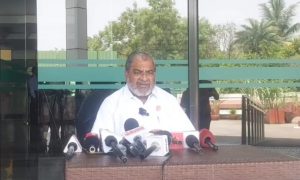Pune: ‘High-Rise Construction is Not Just a Design Challenge; It’s Also an Ecological Challenge’

Pune, 21st April 2025: “High-rises aren’t just a design challenge—they’re a planning, behavioral, and ecological challenge,” opined city planners, urban planners, engineers, architects, and policymakers in a recently organized thought leadership session titled ‘Rise of the High Rise
The session, hosted by the FOCUS Pune Chapter at the Hyatt Residency, brought together city planners, engineers, architects, and policymakers to discuss the complexities of building and living in structures that soar beyond 150 meters
FOCUS (Forum of Critical Utility Services) is a reputable national-level organization, and its Pune Chapter brought together over 120 professionals from across the construction and built environment sectors, including structural engineers, architects, service consultants, contractors, lift manufacturers, and technology providers.
Voices from both cities shared their perspectives. From Ashish Rakheja, President of FOCUS National, Ar. Sandeep Shikre, Vice President of FOCUS; J.P. Shroff, former Chairman of FOCUS Western Zone and Owner of Shroff Group; Arvind Jain, Vice President of CREDAI Pune Metro; Pranati Munot, Chair of the FOCUS Pune Chapter and MD of Sustain and Save; and key government officials like Deepak Singla, Additional Commissioner, PMRDA, the discussion was both technical and deeply human.
This vibrant gathering featured multiple panel discussions with some of the most respected and accomplished professionals and experts in the construction industry, who had come from various parts of the country. The discussions centered around Pune’s transformation from a calm, leisurely city to a vibrant, dynamic, vertically urbanized one.”
Architect Milind Changani said, “’Building taller, above 150 meters, comes at a significant cost, nearly double the standard of 70 meters. But the price isn’t just financial. The challenges of structural integrity, fire and life safety, waste and water systems, and the psychological readiness of residents were all brought to the table, and unique technological solutions were discussed to deal with such challenges.”
Technology was hailed as the enabler—IoT, BIM (Building Information Modelling), district cooling systems, drones, and even solar panels on façades were spotlighted as the future. The integration and application of cutting-edge technologies such as drones, AI, BIM, IoT, and predictive data analytics took center stage.
Chirag Dedhiya shared data indicating that, if used extensively in high-rises and large-scale public projects, technologies like BIM could cut building costs by up to 20%. The event was also made carbon neutral, as Sustain and Save Pvt Ltd measured and offset the carbon footprint of the entire gathering.
‘High-rises change the way we live and interact. We need to prepare people, not just implement technology,’ said one speaker. This includes everything from training residents to designing for better public transport connectivity.
After all, if buildings go vertical but traffic stays horizontal, city life becomes more stressful, not less. Architect Milind Changani presented an eye-opening statistic: India has just 200 high-rises compared to China’s 3,200, most of which are in Mumbai. Pune is next in line to go vertical. But, as the session revealed, going high requires deep thinking.
A series of MOUs was signed between FOCUS and various engineering and postgraduate institutions, giving these institutions access to FOCUS’s high-caliber, international-standard professional members, opening up real-life, application-oriented upskilling opportunities for students.
This event was supported by sponsors like KSB, KONE, Magnus Ventures, Leap Info Systems, YelloSKYE, and Sustain and Save. Chairperson Pranati Munot expressed her heartfelt gratitude to all participants and speakers, acknowledging the collaborative spirit that made the seminar a resounding success.








